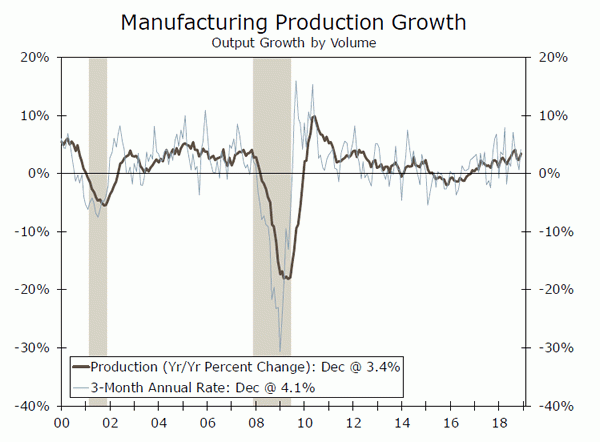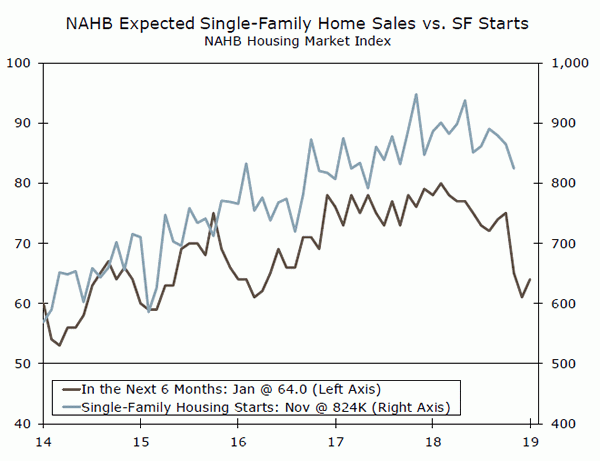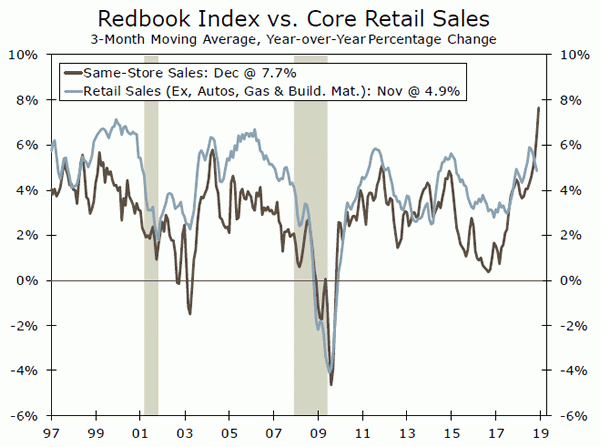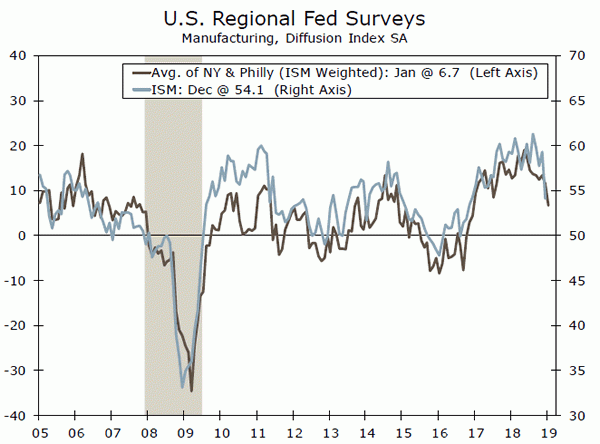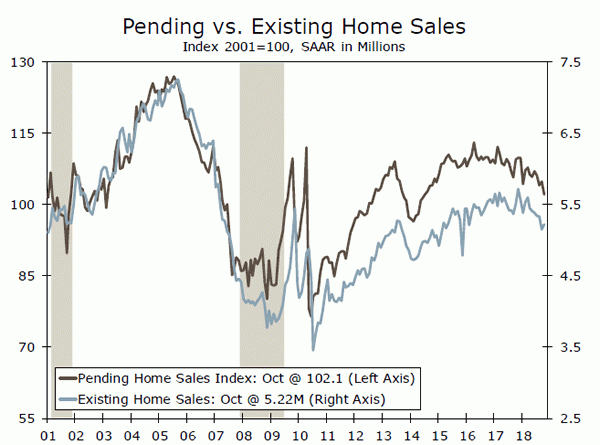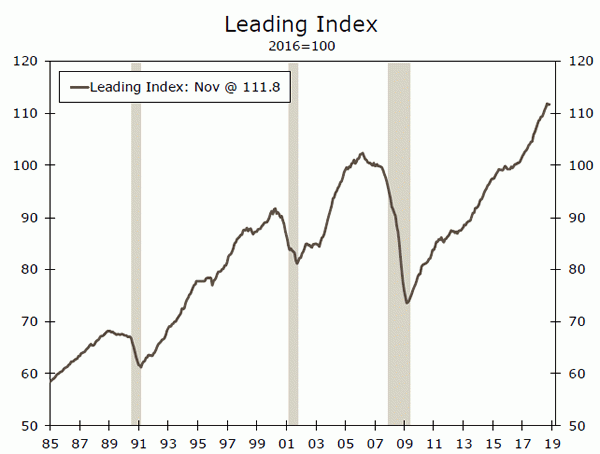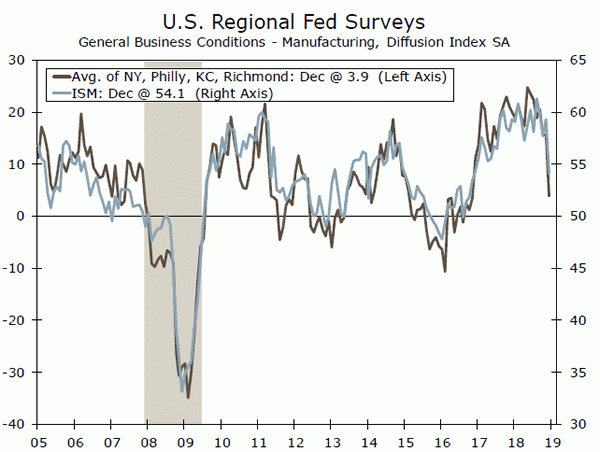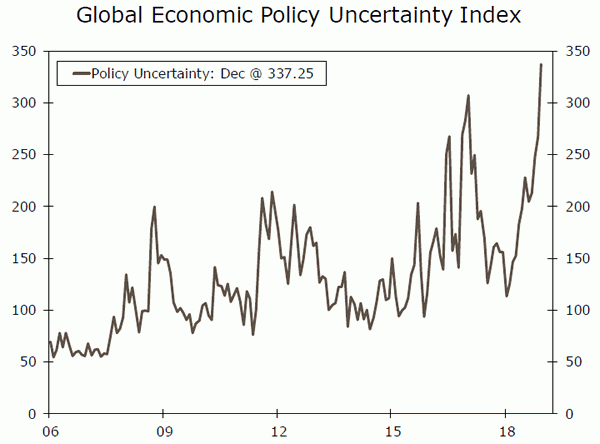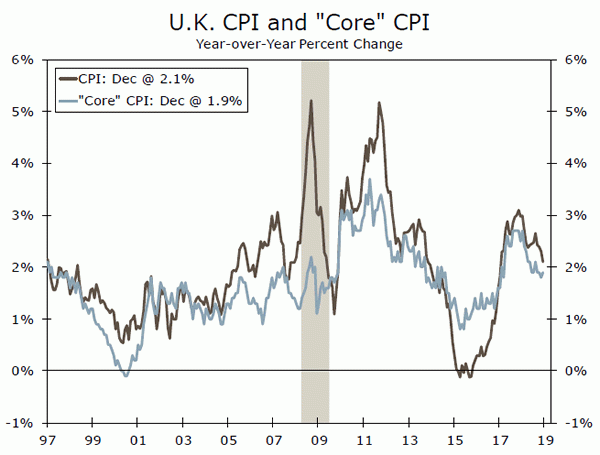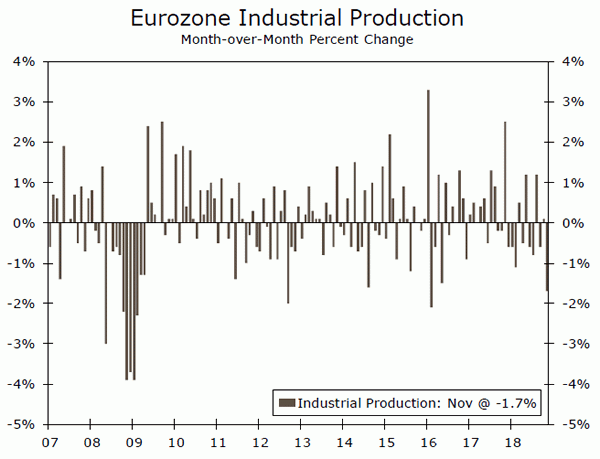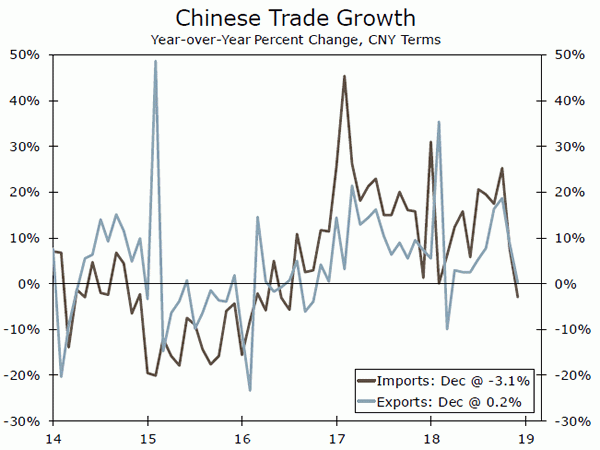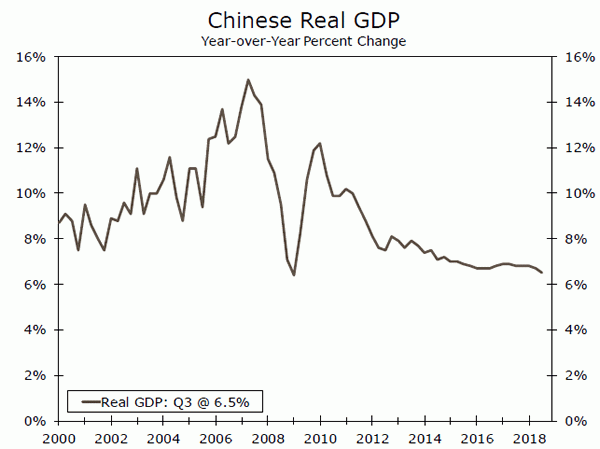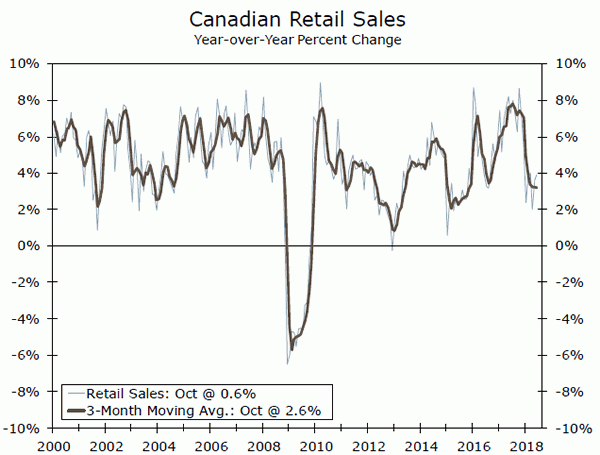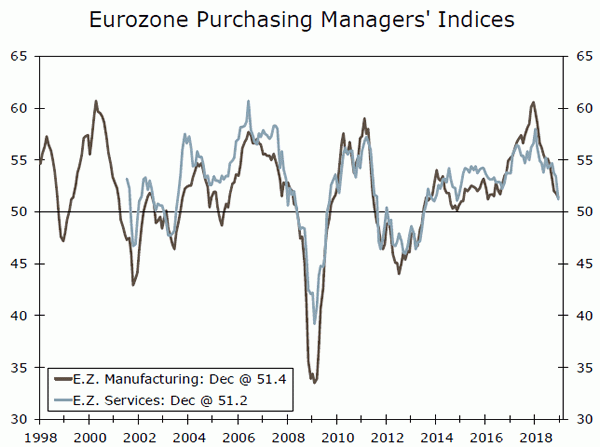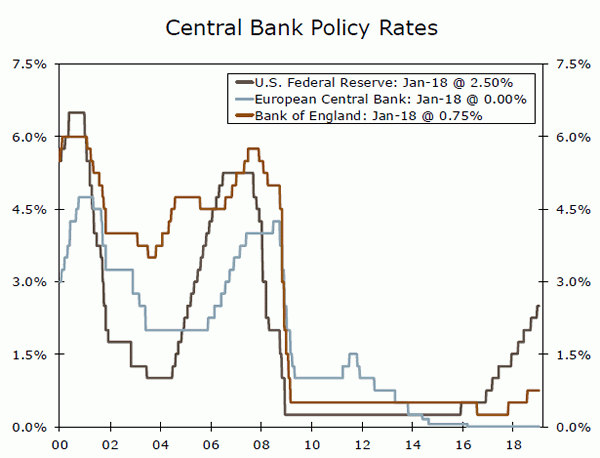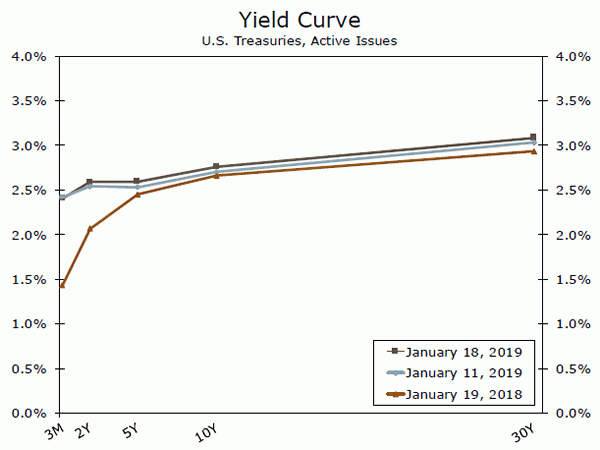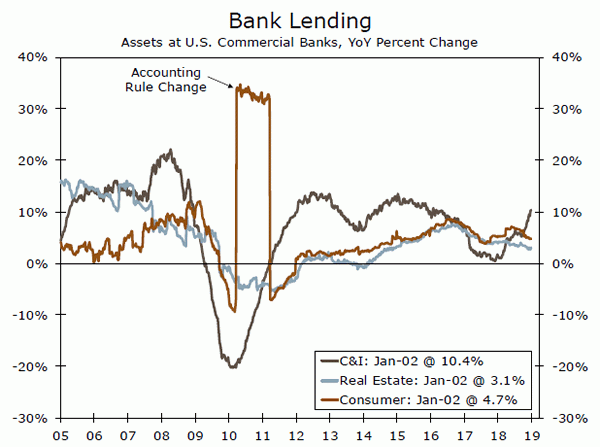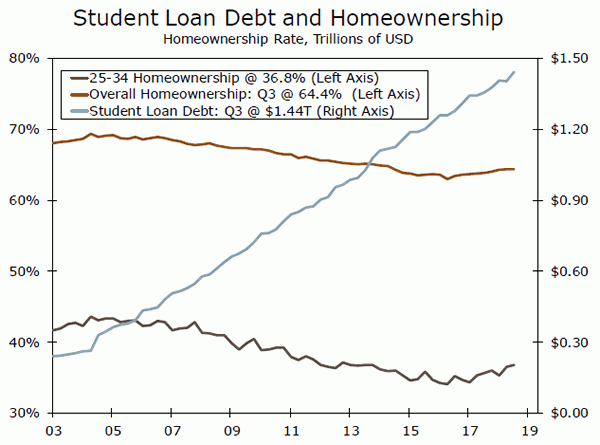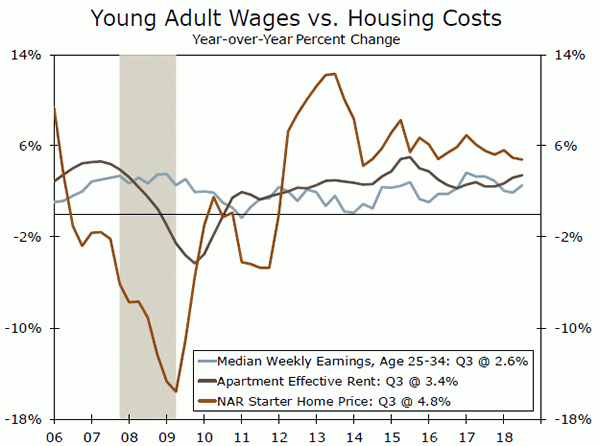U.S. Review
Available Data Show U.S. Economy Is Hanging in There
- Industrial production rose 0.3% in December, driven by a 1.1% jump in manufacturing output. Details of the Empire and Philly Fed manufacturing surveys, however, suggest that the factory sector slowed in January.
- Conditions in the housing market look to be stabilizing, with the NAHB homebuilder survey recovering two points in January and mortgage purchase applications rising.
- The ongoing partial government shutdown delayed the December reports for housing starts and retail sales this week.
Hanging in There
The ongoing partial federal government shutdown meant a number of economic data reports were not released this week. Among them were what would have been two of the major focal points—housing starts and retail sales.
The housing market has been an area of concern in recent months, as buyers and builders have grappled with higher mortgage rates and costs that have led to a further deterioration in affordability. Homebuilder sentiment plummeted in December, sparking fears that the slowdown was set to intensify this year. While the NAHB index remains well-below its level this time last year, builders reported better conditions in January with the index edging up two points (top chart).
The retreat in mortgage rates over the past two months has also helped allay concerns about the housing market. Since mid- November, conventional rates have fallen about 50 bps. Buyers look to be stepping back into the market. Mortgage applications for purchases have jumped more than 10% in each of the past two weeks to reach a new cycle high.
The postponed release of the December retail sales report— arguably the most important retail report of the year—comes as U.S. growth prospects look increasingly reliant on consumers. The good news is that private retails sales reports painted a strong picture of spending in December. Redbook same-store sales, which closely track core retail sales, at physical stores were up were more than 6% every week in December (middle chart).
The bad news is that clouds continue to hang over the industrial side of the economy. The Empire and Philly Fed surveys for January were mixed on the headline, but details pointed to slower activity in the factory sector. The headline of both surveys are derived from independent questions on business activity; constructing each index like the ISM (equal weighting of production, new orders, employment, supplier deliveries and inventories) showed further slippage (bottom chart).
The ISM and regional PMIs remain in positive territory, however, and hard data suggest industrial output is hanging in there. Overall industrial production rose 0.3% in December, while manufacturing output rose 1.1% amid a nearly a 5% jump in autos production. With global growth easing and trade/general policy uncertainty elevated, we would not be surprised to see manufacturing production ease up over the next couple of months.
As the shutdown has dragged on, concerns are mounting about its ultimate impact to growth. The length of the shutdown points to growing spillovers in terms of consumer spending, not just as federal workers have now missed a paycheck, but for the swath of contractors reliant on government work.
For now, the impact in terms of employment looks to be contained. While the Labor Department reported 10,500 former federal employees filing initial jobless claims—5,000 more than the previous week—total initial claims fell for a second straight week. That suggests most contractors are still on their company payrolls, although it does not shed light on pay and spending.
U.S. Outlook
Existing Home Sales • Tuesday
After rebounding 1.9% in November, we are expecting existing home sales to fall by an identical amount in December. Sales have been held back by higher mortgage rates in November and December and poor weather, which kept many potential home buyers indoors. Sales are also being hindered by a lack of affordable product, and overall inventories remain relatively low.
Home prices should moderate further, as sales have weakened significantly in parts of the country where home prices tend to be more expensive, including major markets along the West Coast and the more densely populated areas in the Northeast. Inventories of higher-priced homes have risen and sellers are cutting their asking prices. We are looking for this to continue this year, as overall economic growth struggles and homeowners in higher tax states come to grips with the new tax law.
Previous: 1.9% Wells Fargo: -1.9% Consensus: -0.9% (Month-over-Month)
Leading Indicators • Thursday
Forecasts for the index of leading indicators are clouded by the lack of economic news released this past month due to the government shutdown. The leading indicators are produced by the Conference Board and will published on Thursday. Our own forecast calls for a 0.1% percent drop, which is in line with the consensus.
Much of what goes into the leading indicators and coincident indicators has been reported. The BLS has continued to report data on jobless claims, the ISM data is available and all of the financial components are available. What is missing, however, is fairly vital – data on new orders for consumer goods, orders for nondefense capital goods, excluding aircraft; and building permits. This is the most cyclical part of the economy and is where much of the recent weakness has been. The missing data and how the Conference Board deals with it means that this data may be revised substantially once the government shutdown finally ends.
Previous: 0.2% Wells Fargo: -0.1% Consensus: -0.1% (Month-over-Month)
Other Indicators
The government shutdown will take a huge bite out of the economic releases this coming week. We will miss data on international trade, retail and wholesale inventories, new home sales, factory orders and housing starts. We will continue to receive data on weekly jobless claims on Thursday, which are already exceptionally low at just 213,000 and expected to fall slightly further for the week of January 19. We will also get reports on manufacturing conditions from the Richmond Fed and Kansas City Fed on Wednesday and Thursday, which we do not forecast. The regional Fed manufacturing surveys all turned lowed in December but have been mixed so far this month. The Empire Survey plunged 7.6 points to 3.9 in January, while the Philadelphia Fed survey rose 7.9 points to 17. We will probably see mixed results from the factory sector once again this week, with the Richmond Fed likely holding up better than the Kansas City Fed, which is seeing some pullback in energy-related investment.
Previous: Richmond Fed: -8, Kansas City Fed: 3
Global Review
Global Uncertainties Abound
- The international events and data of the past week pointed to a still uncertain outlook, and suggest it might still take some time for global economies to stabilize and global central banks to resume tightening.
- In the U.K., PM May’s Brexit deal was heavily defeated by the Parliament. Although the government subsequently survived a no-confidence vote the path forward remains uncertain, although we ultimately expect the Brexit deal to be struck.
- In the Eurozone, uncertainty relates primarily to the path of the economy, highlighted over the past week by subdued German GDP and a large fall in Eurozone industrial production.
Global Uncertainties Abound
The focal point of the global economic picture this week was the United Kingdom, specifically a parliamentary vote on U.K. Prime Minister Theresa May’s Brexit withdrawal deal. While a defeat was widely expected, the margin of defeat (432-202) was larger than expected. Still, May’s government survived a vote of no confidence following the initial defeat on the withdrawal deal, and May is now expected to hold cross-party talks to devise a “plan B” on how to proceed. These discussions could involve a proposal for a second referendum, but we expect that proposal will be denied, and instead we expect U.K. parliament will ultimately devise an alternative deal that appeases the European Union and allows the United Kingdom to leave the E.U. with a deal on March 29. In the interim, until there is a clear path forward, we see downside risks for the U.K. economy and the pound as the uncertainty weighs on business, consumer and investor sentiment. Indeed, there was little in this week’s U.K. data that was upbeat in tone. The December CPI was benign, slowing to 2.1% year over year, while core CPI firmed slightly to 1.9%. Meanwhile December retail sales fell 0.9% month over month, partly reversing their sizeable November gain.
Another area of lingering uncertainty is the overall strength of the Eurozone economy. While the European consumer appears to be holding up OK, including a gain in November retail sales and drop in unemployment, the manufacturing sector remains under significant pressure. This week the Eurozone reported a 1.7% month-over-month decline in November industrial production, with weakness broad based across the major economies of Germany, France, Italy and Spain. On an annual basis Eurozone industrial production fell 3.3%, the largest decline since late 2012. Meanwhile Germany, the region’s largest economy, reported full year 2018 GDP growth on 1.5%, down from 2.2% in 2017. In what was a relatively minor silver lining, the German statistics office said there were “signs of a slight recovery” in the fourth quarter compared to the third quarter.
The outlook for China’s economy also remains somewhat uncertain, despite some signs of progress on the U.S.-China trade front. China has resumed purchases of certain U.S. products, including soybeans, and also temporarily suspended additional tariffs on U.S. made vehicles. Meanwhile, U.S. President Trump has indicated he thinks a trade deal is likely. That said, the timing and scope of any trade deal, if reached, remains uncertain. And for now, U.S. tariffs on Chinese goods that were imposed earlier in 2018 appear to be having an increasing impact. After what appeared to be some front-loading of Chinese exports in recent months, perhaps aimed add lessening the pain from any additional U.S. trade actions in 2019, trade growth slowed noticeably in December. In local currency terms Chinese exports slowed to just 0.2% year over year, while imports actually fell 3.1%. Against that backdrop authorities continue to pledge further monetary and fiscal stimulus measures aimed at supporting the Chinese economy.
Global Outlook
China GDP • Monday
Next week offers an important scorecard on the performance of China’s economy in 2018, in the form of Q4 GDP as well as December activity. China’s economy displayed a steady easing in growth last quarter, a trend that we believe continued into the fourth quarter. We forecast Q4 GDP slowed to 6.4% year over year, which would match the slowest pace of Chinese growth seen during the global financial crisis. U.S.-China trade tensions, and an associated slowing in Chinese export growth, have been contributing factors to the slowdown, prompting authorities to respond with growth supportive monetary and fiscal policies.
Almost as interesting as the overall pace of economic growth will be insights into economic performance by sector. On that front, December retail sales are forecast to have remained steady at 8.1% year over year, but industrial production growth is expected to have eased further, to 5.3% year over year.
Previous: 6.5% Wells Fargo: 6.4% Consensus: 6.4% (Year-over-Year)
Canada Retail Sales • Wednesday
Canadian consumers spent a moderate pace through much of 2018, with household consumer spending growth averaging a 1.7% pace during the first nine months of the year, and contributing to subdued GDP growth overall. In its latest Monetary Policy Report the Bank of Canada projected a temporary slowing in growth as lower oil prices depress investment and output and, in that context, consumer spending and retail sales will be monitored in the months ahead as to whether they can offer a source of relative stability. Nominal retail sales rose 0.3% month over month in October and in fact have not declined on a monthly basis since June. That run is expected to have come to end in November, with the consensus forecast for retail sales to have fallen by 0.7%, although with lower gasoline prices likely a factor behind that expected decline. November manufacturing sales are also due—sales have been mixed recently, with declines in two of the past three months, and a further fall is expected in November.
Previous: 0.3% Consensus: -0.7% (Month-over-Month)
Eurozone PMIs • Thursday
As concerns about an economic slowdown have intensified, the Eurozone PMI surveys have become increasingly closely followed measures of the economy’s health over the past several months. Q3 GDP grew just 0.2% quarter over quarter (not annualized) and, reflective of that sluggish pace of growth, the manufacturing PMI has fallen for five straight months, and the services PMI for three straight months, through the latest data for December 2018. For the manufacturing sector that underwhelming trend is expected to have continued into January, with the consensus forecasting a slight fall to 51.3. In contrast the services PMI should show some improvement, with a forecast increase to 51.5.
The European Central Bank also announces its monetary policy decision next week. No change in policy is expected, and most interest will be in whether the central bank formally shifts its balance of risks around the growth outlook as being tilted to the downside.
Previous: 51.4 (Manufacturing), 51.2 (Services) Consensus: 51.3 (Manufacturing), 51.5 (Services)
Point of View
Interest Rate Watch
Fed Speakers Signal Pause
A number of Fed speakers were on the wires this week expounding their views on the outlook for monetary policy. Neel Kashkari, President of the Minneapolis Fed, said that “I’m not seeing evidence to support further hiking,” which was not a huge surprise given that he is widely seen as one of the most dovish members of the Federal Open Market Committee (FOMC). Dallas Fed President Kaplan echoed Kashkari by stating that “the Fed would be wise to give time and be patient.” The comments by Kashkari and Kaplan are interesting, but they are not overly relevant because neither bank president is a voting member of the FOMC this year.
Perhaps more telling were the comments by Esther George, President of the Kansas City Fed, and New York Fed President John Williams. Not only are George and Williams voting members of the FOMC this year, but both tend to have relatively hawkish views. George said that “it seems to me that we should proceed with caution and be patient.” In his speech on Friday, Williams asked the rhetorical question of how the Fed should respond to “an outlook of slowing growth.” He answered his own question in one word: “carefully.” If relatively hawkish members of the FOMC are urging restraint, then it seems likely that the Fed will refrain from raising rates in the foreseeable future.
These comments by Fed policymakers reinforce our own view that the FOMC will remain on hold at the January 30, March 20 and May 1 policy meetings as the committee digests incoming economic data. The government shutdown has precluded the release of some economic data. But we think that once the data start to flow in earnest again they will show that the U.S. economy continues to grow at a pace that is strong enough to push the unemployment rate, which is already near a 50-year low, even lower. If, as we expect, many FOMC members then reason that the tightness in the labor market will lead to further wage acceleration that could potentially lead to higher inflation, then we would look for the FOMC to tap on the brakes again with another 25 bp rate hike this summer.
Topic of the Week
This Week, We Welcome Jen
This week we welcome Jen Licis as the newest analyst to join the Economics group. We wanted to take some time to introduce Jen as she begins work on our team. Jen hails from Ohio, where she recently completed her Masters of Science in Finance with a specialization in Investments at the University of Cincinnati (UC). Jen also completed her undergrad education at UC, and proudly holds a Bachelor’s degree in Economics. Jen solidified her interest in Economics while in college, taking a variety of courses with the highlight being her participation in an Economics study abroad program in Australia. Jen hopes to explore various research topics throughout her time with the group, with a particular interest in foreign exchange and inflation.
Prior to joining Wells Fargo, Jen completed several internships, including at Dealer Tire, Fidelity Charitable and the Financial Industry Regulatory Authority (FINRA). Jen cites her most recent internship with FINRA as giving her a varied perspective on different aspects of the financial services industry, which she believes will help her excel in her current role. Jen’s work in corporate strategy at Dealer Tire as well as her experience with the investment team at Fidelity Charitable have also given her valuable skills to contribute to our group. When not analyzing economic data, Jen pursues her passion for running and staying active, and plans to explore the variety of running trails and outdoor activities Charlotte has to offer.
Credit Market Insights
Majoring in Debt?
Is the housing market another thing that Millennials have “killed”? The homeownership rate fell five percentage points between 2005 and 2014, with an even more pronounced eight point decline among adults aged 25-34. Only 37% of young adults currently own homes, down from a peak of 44%. One explanation for this decline is the explosion in student loan debt. Rising enrollment and skyrocketing tuition costs have caused student loan debt to more than double over the past decade to almost $1.5 trillion—more than total credit card or auto loan debt. It is natural to wonder if this growing indebtedness is discouraging or inhibiting young graduates from doubling down, in a sense, and taking out a mortgage.
In fact, new research from the Federal Reserve estimates that around 20% of the decline in young adult homeownership between 2005 and 2014 can be attributed to higher student loan burdens. Clearly, paying off these loans leaves potential homebuyers with less disposable income to apply toward a monthly mortgage payment, or, perhaps more importantly, toward a down payment. Furthermore, falling behind on these payments can damage credit scores and impair access to affordable financing. The psychological burden of such a debt load— often tens of thousands of dollars, with delinquency rates over 10%—before even the first day of a first job likely also has an effect on the oft-analyzed Millennial psyche.
That said, student loan debt is by and large an investment in one’s human capital with an overwhelmingly positive return. Higher education drives future earnings potential—median weekly earnings for those with a bachelor’s degree are more than 60% higher than for those with only a high school diploma. College graduates then, in theory, should eventually be better able to afford homeownership, all else equal. All of this takes place, however, amidst a broader context of declining affordability. For years, home price appreciation and rent growth have outpaced wage growth, mortgage rates have climbed higher and there has been insufficient new supply in the markets in which Millennials want to live.




